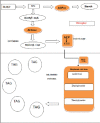Proteomic approaches in microalgae: perspectives and applications
- PMID: 28667637
- PMCID: PMC5493573
- DOI: 10.1007/s13205-017-0831-5
Proteomic approaches in microalgae: perspectives and applications
Abstract
Biofuels are the promising sources which are produced by various microalgae or in the form of metabolic by-products from organic or food waste products. Microalgae have been widely reported for the production of biofuels since these have a high storage of lipids as triacylglycerides, which can mainly be converted into biofuels. Recently, products such as biodiesel, bioethanol and biogas have renewed the interest toward the microalgae. The proteomics alone will not pave the way toward finding an ideal alga which will fulfill the current energy demands, but a combined approach of proteomics, genomics and bioinformatics can be pivotal for a sustainable solution. The present review emphasizes various technologies currently involved in algal proteomics for the efficient production of biofuels.
Keywords: Biofuel; ITRAQ; Microalgae; Proteomics; Systems biology.
Conflict of interest statement
The authors declare no conflict of interest.
Figures
References
Publication types
LinkOut - more resources
Full Text Sources
Other Literature Sources



